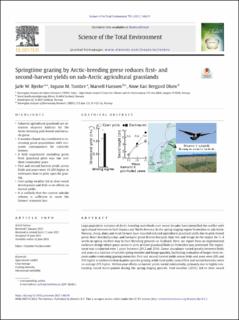| dc.contributor.author | Bjerke, Jarle W. | |
| dc.contributor.author | Tombre, Ingunn | |
| dc.contributor.author | Hanssen, Marvell | |
| dc.contributor.author | Olsen, Anne Kari Bergjord | |
| dc.date.accessioned | 2021-10-28T09:07:20Z | |
| dc.date.available | 2021-10-28T09:07:20Z | |
| dc.date.created | 2021-06-25T15:29:04Z | |
| dc.date.issued | 2021-06-22 | |
| dc.identifier.citation | Bjerke, J. W., Tombre, I. M., Hanssen, M., & Olsen, A. K. B. (2021). Springtime grazing by Arctic-breeding geese reduces first- and second-harvest yields on sub-Arctic agricultural grasslands. Science of The Total Environment, 793, 148619. | en_US |
| dc.identifier.issn | 0048-9697 | |
| dc.identifier.uri | https://hdl.handle.net/11250/2826221 | |
| dc.description.abstract | Large population increases of Arctic-breeding waterfowls over recent decades have intensified the conflict with agricultural interests in both Eurasia and North America. In the spring-staging region Vesterålen in sub-Arctic Norway, sheep, dairy and meat farmers have reported reduced agricultural grassland yields due to pink-footed geese Anser brachyrhynchus and barnacle geese Branta leucopsis that rest and forage in the region for 3–4 weeks in spring on their way to their breeding grounds on Svalbard. Here, we report from an experimental exclosure design where goose access to plots at three grassland fields in Vesterålen was prevented. The experiment was conducted over 3 years between 2012 and 2014. Goose abundance varied greatly between fields and years as a function of variable spring weather and forage quantity, facilitating evaluation of longer-term impacts under contrasting grazing intensities. First and second harvest yields across fields and years were 20% and 19% higher in exclosures than in plots open for grazing, while total yields (sum of first and second harvests)were on average 27% higher. Within-year effects on harvest yields varied substantially, primarily due to highly contrasting sward development during the spring-staging periods. Cool weather (2012) led to slow sward. Agricultural conflict Crop damage Grazing intensity Interannual variability | en_US |
| dc.language.iso | eng | en_US |
| dc.publisher | Elsevier B.V. | en_US |
| dc.rights | Navngivelse 4.0 Internasjonal | * |
| dc.rights.uri | http://creativecommons.org/licenses/by/4.0/deed.no | * |
| dc.title | Springtime grazing by Arctic-breeding geese reduces first- and second-harvest yields on sub-Arctic agricultural grasslands | en_US |
| dc.type | Peer reviewed | en_US |
| dc.type | Journal article | en_US |
| dc.description.version | publishedVersion | en_US |
| dc.rights.holder | © 2021 The Authors | en_US |
| dc.subject.nsi | VDP::Geofag: 450 | en_US |
| dc.subject.nsi | VDP::Geosciences: 450 | en_US |
| dc.source.volume | 793 | en_US |
| dc.source.journal | Science of the Total Environment | en_US |
| dc.identifier.doi | 10.1016/j.scitotenv.2021.148619 | |
| dc.identifier.cristin | 1918592 | |
| dc.relation.project | Andre: County Governor of Nordland | en_US |
| dc.relation.project | Egen institusjon: Norwegian Institute for Nature Research (NINA) | en_US |
| dc.relation.project | Framsenteret: High North Research Centre for Climate and the Environment | en_US |
| dc.relation.project | Andre: Norwegian Environmental Agency | en_US |
| dc.relation.project | Norges forskningsråd: 204342 | en_US |
| dc.source.articlenumber | 148619 | en_US |
| cristin.ispublished | true | |
| cristin.fulltext | original | |
| cristin.qualitycode | 2 | |

